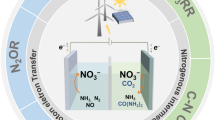Abstract
Nitrogen is the most abundant gas in the Earth’s atmosphere (nearly 78%). The natural process of its fixation to usable nitrogen species, viz., ammonia, is carried out by certain diazotrophic bacteria containing the enzyme ‘nitrogenase’. This transformation is vital for several biochemical and physicochemical processes on Earth. Thus, the fixation of atmospheric N2 has always been a topic of interest. Fritz Haber was acknowledged by the Nobel awarding committee in 1918 for finding a solution for the same, and Carl Bosch developed it in industrial scale. Despite this development, the Haber-Bosch process (HBP) has certain shortcomings, particularly the fact that it requires high temperature and pressure, i.e., the process is not clean, unlike that by Nature. In this context, the electrocatalytic community is striving hard to use several types of molecular catalysts to transform the highly unreactive nitrogen to its more useful form, like ammonia, under ambient conditions.
Similar content being viewed by others
Suggested Reading
B M Hoffman, D Lukoyanov, Z Y Yang, D R Dean, L C Seefeldt, Mechanism of nitrogen fixation by nitrogenase: The next stage, Chem. Rev., Vol.114, pp.4041–4062, 2014.
D E Canfield, A N Glazer, P G Falkowski, The evolution and future of Earth’s nitrogen cycle, Science, Vol.330, pp.192–196, 2010.
S J Ferguson, Nitrogen cycle enzymology, Curr. Opin. Chem. Biol., Vol.2, pp.182–193, 1998.
B K Burgess and D J Lowe, Mechanism of molybdenum nitrogenase, Chem. Rev., Vol.96, pp.2983–3011, 1996.
B K Burgess, S Wherland, W E Newton and E I Stiefel, Nitrogenase reactivity: Insight into the nitrogen-fixing process through hydrogen-inhibition and HD-forming reactions, Biochemistry, Vol.20, pp.5140–5146, 1981.
D R Lide, CRC Handbook of Chemistry and Physics, Internet version CRC Press, 2005.
F Haber, The Synthesis of Ammonia From Its Elements Nobel Lecture, 1920. https://www.nobelprize.org/prizes/chemistry/1918/haber/biographical/.
J W Erisman, M A Sutton, J Galloway, Z Klimont, W Winiwarter, How a century of ammonia synthesis changed the world, Nat. Geosci., Vol.1, pp.636–639, 2008.
W M Stewart, D W Dibb, A E Johnston, T J Smyth, The contribution of commercial fertilizer nutrients to food production, Agron. J., Vol.97, pp.1–6, 2005.
S L Foster, S I P Bakovic, R D Duda, S Maheshwari, R D Milton, S D Minteer, M J Janik, J N Reneer and L F Greenlee, Catalysts for nitrogen reduction to ammonia, Nature Catalysis, Vol.1, pp.490–500, 2018.
S Mukherjee, D A Cullen, S Karakalos, K X Liu, H Zhang, S Zhao, H Xu, K L More, G F Wang and G Wu, Metal-organic framework-derived nitrogen-doped highly disordered carbon for electrochemical ammonia synthesis using N2 and H2O in alkaline electrolytes, Nano Energy, Vol.48, pp.217–226, 2018.
X Yang, J Nash, J Anibal, M Dunwel, S Kattel, E Stavitski, K Attenkofer, J G G Chen, Y S Yan and B J Xu, Mechanistic insights into electrochemical nitrogen reduction reaction on vanadium nitride nanoparticles, J. Am. Chem. Soc., Vol.140, pp.13387–13391, 2018.
Cheng Tang and Shi-Zhang Qiao, How to explore ambient electrocatalytic nitrogen reduction reliably and insightfully, Chem. Soc. Rev., Vol.48, pp.3166–3180, 2019.
X Cui, C Tang and Q Zhang, A review of electrocatalytic reduction of dinitrogen to ammonia under ambient conditions, Adv. Energy Mater., Vol.8, p. 1800369, 2018.
X H Guo, Y P Zhu, T Y Ma, Lowering Reaction temperature: Electrochemical ammonia synthesis by coupling various electrolytes and catalysts, J. Energy Chem., Vol.26, pp.1107–1116, 2017.
S L Foster, S I P Bakovic, R D Duda, S Maheshwari, R D Milton, S D Minteer, M J Janik, J N Renner, L F Greenlee, Catalysts for nitrogen reduction to ammonia, Nat. Catal., Vol.1, pp.490–500, 2018.
A J Kendall, S I Johnson, R M Bullock, M T Mock, Catalytic silylation of N2 and synthesis of NH3 and N2H4 by net hydrogen atom transfer reactions using a chromium P4 macrocycle, J. Am. Chem. Soc., Vol.140, pp.2528–2536, 2018.
Paramita Saha, Sk. Amanullah, and Abhishek Dey, Electrocatalytic reduction of nitrogen to hydrazine using a trinuclear nickel complex, J. Am. Chem. Soc., Vol.142, pp.17312–17317, 2020.
B M Lindley, A M Appel, K Krogh-Jespersen, J M Mayer, A J M Miller, Evaluating the thermodynamics of electrocatalytic N2 reduction in acetonitrile, ACS Energy Lett., Vol.1, pp.698–704, 2016.
L Merakeb and M Robert, Advances in molecular electrochemical activation of dinitrogen, Current Opinion in Electrochemistry, Vol.29, pp. 100834–100840, 2021.
Author information
Authors and Affiliations
Corresponding authors
Additional information
Jaydeep Basu has graduated from the Department of Chemistry, St Xavier’s College, Kolkata, and currently, is pursuing post-graduation in chemistry at IIT, Delhi.
Sanjib Ganguly is an associate professor at the Department of Chemistry, St Xavier’s College, Kolkata. He holds a PhD in inorganic chemistry from IACS, Kolkata (under JU) and his research interests include redox non-innocent ligands and their application in electron transfer organic reactions/catalysis.
Rights and permissions
About this article
Cite this article
Basu, J., Ganguly, S. Electrocatalytic Nitrogen Reduction Reaction (NRR). Reson 28, 279–291 (2023). https://doi.org/10.1007/s12045-023-1548-x
Published:
Issue Date:
DOI: https://doi.org/10.1007/s12045-023-1548-x




